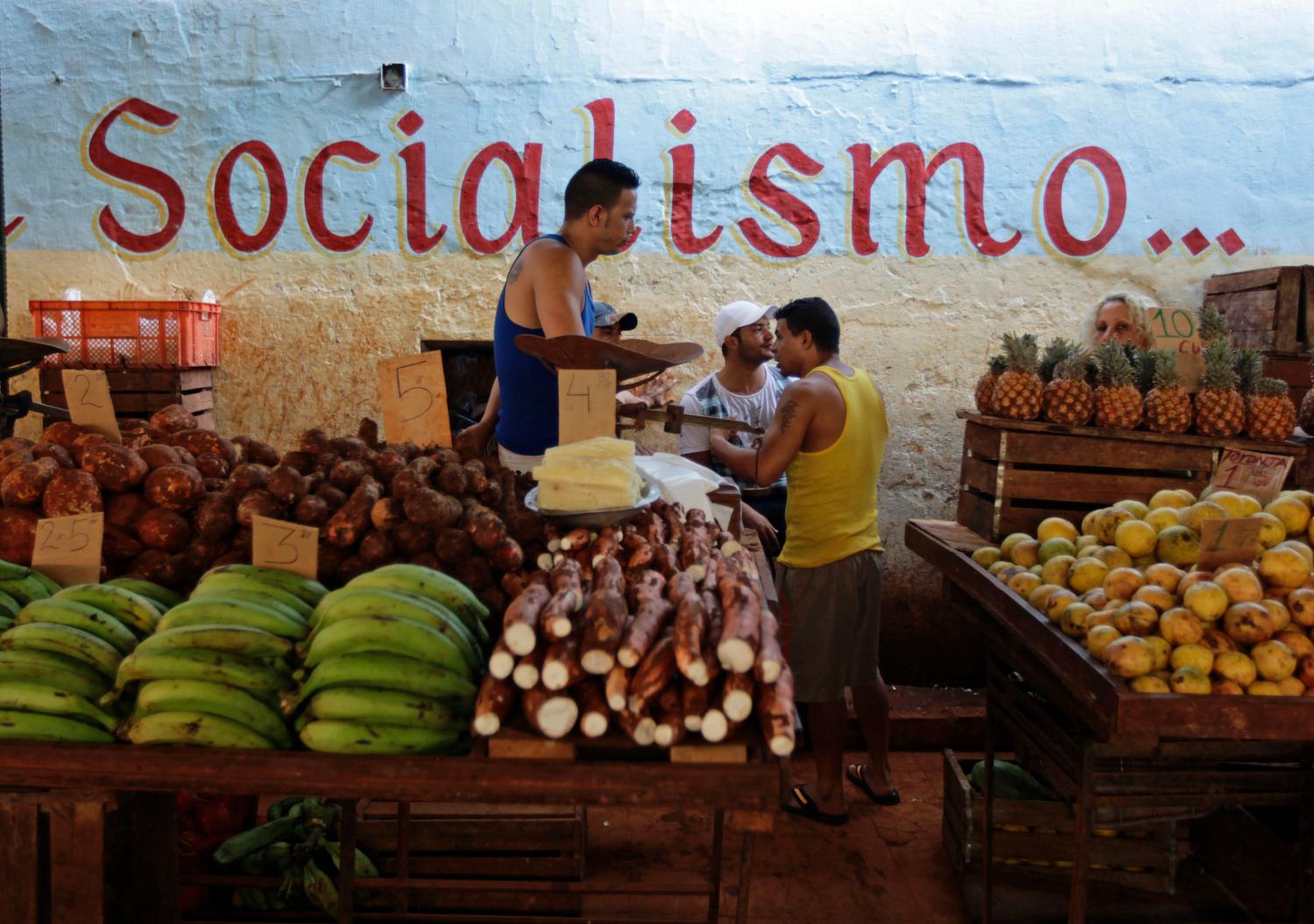On April 6, 2017, the Brookings Institution and the Research Initiative for the Sustainable Development of Cuba (RISDoC) co-hosted “Sustainable Development: The Path to Economic Growth in Cuba,” a daylong, experts seminar, which focused on Cuba’s long-term sustainability planning. The executive summary details the main points of consensus and areas for future research and discussion.
As it prepares for the post-Castro era in February 2018, Cuba has the opportunity to reenergize its economic reform agenda to promote sustainable growth and stability on the island. To do so, the country will have to emerge from its current state of economic stagnation, heavy reliance on imports, unsustainably low state wages, and ongoing brain drain. The December 17, 2014 announcement of normalization between Cuba and the United States renewed hope that, assuming continued progress toward lifting the embargo, Cuba would be able to access U.S. markets and investment capital to breathe new life into its economy. However, the election of Donald Trump has brought that into question and reaffirmed the view that Cuba should secure its own development opportunities with or without the United States.
Experts are increasingly convinced that peer-to-peer relationships between Cubans and Americans are a more effective route to expanding bilateral relations for increased development on the island. The newly formed Research Initiative for the Sustainable Development of Cuba (RISDoC) is putting this idea to the test, bringing together a diverse group of members that combine deep knowledge of the Cuban context with recognized expertise in sustainability, economic development, and business acumen in order to support Cuban development efforts and achieve optimum sustainability outcomes. In February 2017, RISDoC held an inaugural conference in Havana that brought together universities and research centers, NGOs, and government including representatives of Cuba’s ministries of agriculture, energy and mines, tourism, and science, technology and environment. The conference sought to open channels for further communication about sustainability at the government and grass roots levels.
On April 6, 2017, the Brookings Institution and RISDoC co-hosted an experts seminar titled “Sustainable Development: The Path to Economic Growth in Cuba,” which focused on Cuba’s long-term sustainability planning, building on the discussions that took place during Brookings’s May 2016 conference “Opportunities for Sustainable Development in Cuba.” The discussion focused on three main themes: Cuba’s economic response to changing regional and global contexts (including normalization with the United States), sustainable agriculture, and renewable energy.
The event brought together Cuban, U.S., and other international thought leaders and practitioners from multiple disciplines for an in-depth discussion on the intersections between sustainability, economic development, and public-private partnerships. The first panel set the stage, highlighting Cuba’s current state of economic stagnation and difficulty attracting and approving outside investment; then pointed to Cuba’s existing economic assets and the ways in which they could be leveraged to create growth through a sustainable development model. The second examined sustainable agriculture, arguing that the Cuban government needs to make farming a more attractive career for young Cubans (most importantly by providing better wages) in order to address the current state of food insecurity, which has been exacerbated by the rising food demands of the tourism industry. Finally, the third panel discussed the Cuban government’s goal to substantially increase renewable energy sources on the island by 2030 and pointed to Cuba’s existing energy infrastructure and an abundance of potential knowledge sharing as key assets that should be utilized to achieve that goal without reinventing the wheel. Throughout the day of plenary and working group discussions, participants also discussed the evolution of U.S.-Cuba relations and how they might affect Cuba’s sustainable development trajectory.
Opportunities and Challenges for Economic Development
Current challenges. Jumpstarting the Cuban economy will not be an easy task. From 2008 to 2015, investment in Cuba fell 17 percent, exports dropped 5 percent, and real GDP shrank by nearly 1 percent. Cuba currently has a fiscal deficit above 12 percent as well as a significant trade deficit, due in large part to the ongoing crisis in Venezuela. Cuba’s dual currency system, the country’s remaining debt, and the U.S. embargo all continue to present major challenges to development and growth as well.
This is not to say Cuba hasn’t made some progress. In 2015, Cuba renegotiated a major portion of its official debt. After reaching agreements with multiple debtors including China, Mexico, and Russia, a high percentage of Cuba’s debt was forgiven and the country’s Moody’s risk rating was upgraded from stable to positive. Internally, the government has now granted licenses to over 500,000 self-employed entrepreneurs (cuenta propistas) and nearly 500 cooperatives, providing opportunities for increased individual income as well as government savings due to the decrease in state employment. However, the 300 permitted categories for cuenta propistas are still limited. In the case of cooperatives, the majority are located in Havana (limiting this source of economic growth in other cities), and many have been converted from state-owned businesses rather than creating new enterprises.
Cuba also has important barriers to external financing and foreign direct investment (FDI) including the U.S. embargo, non-engagement with the international financial institutions (IFIs), restrictions on eligibility for FDI, and bureaucratic constraints that have the capacity to dissuade the most interested of investors. One attempt to address this is the Foreign Investment Act No. 118 of 2014, under which the government publishes an annual Business Opportunity Portfolio of approved opportunities for foreign investment. So far, the Cuban government has approved 60 businesses (mainly joint ventures and management contracts), over half of which are in the tourism sector. Experts questioned whether this pace was sufficient to have an impact on growth.
Sustainable development. As the Cuban economy develops, will it be able to leap-frog industrialization and move straight to more sustainable models of development, or will it follow a more traditional path? Experts agreed that the Cuban government should prioritize sustainability to provide long-term solutions to its current growth problems. They identified three key facets of sustainability (social, economic, and environmental), which should be considered in relationship to each other when developing policy.
Removing barriers to investment is high on the economic priority list. Additional recommendations included: 1) increasing government transparency as a first step toward a relationship with the IFIs; 2) attracting increased investment (particularly FDI); 3) diversifying exports; 4) producing exports at globally competitive prices; 5) decentralizing the management of state-owned enterprises; 6) investigating opportunities for microcredit through the IFIs; and 7) promoting urban cooperatives.
Cuba already possesses many assets that can be harnessed to accomplish these goals. The most obvious is the country’s tourism boom, which is a new, important source of income on the island. Cuba received four million tourists in 2016, and expects to receive even more in 2017 when Americans will become the second largest tourist nationality. Cuba also has a well-educated population, strong civic culture, well-designed laws and regulations, and a government work force that is capable of executing polices once the government has approved them.
The government should employ new strategies to utilize those assets more productively and efficiently. Experts pointed to collaboration and idea exchange as key factors in promoting sustainable growth, specifically creating space for collaboration between the Cuban government, academia, businesses, and NGOS to share their experiences of development.
Agriculture
Recent reports of food shortages caused, at least in part, by increased tourist demand have renewed attention to agricultural production in Cuba. Experts disagreed on whether this was actually the case, particularly on what kinds of foods Cubans are no longer able to access as easily as before. One panelist expressed concern that the best, most nutritious food produced on the island would go to tourists rather than Cubans, while another felt that food shortages were limited to artisanal and luxury food items.
Production. All experts agree that Cuban agriculture is producing below its potential, forcing an unsustainable reliance on imports. Access to land is not the problem; the Cuban government began encouraging sustainable agriculture during the Special Period of the 1990s to increase production and Cuba’s land tenure laws are very advanced. In 1993, the government restructured half of state-owned land into private cooperatives called Basic Units of Cooperative Production, which are member-owned and member-managed under usufruct rights. Additionally, in the late 2000s, the government granted 67 hectares to any person willing to farm the land – over 200,000 Cubans have taken advantage of this offer to date.
Challenges. Most Cubans are simply not incentivized to farm as an occupation. Experts identified multiple reasons for this: 1) low rates of internal investment and administrative barriers to foreign investment; 2) low wages and prices for agricultural producers; 3) lack of (refrigerated) trucks, which leads to high levels of food waste and lost income; and 4) a cultural view that farming is backward and not a profitable job for young Cubans. The prioritization of animal protein in the Cuban diet, particularly beef and milk over fresh vegetables, also contributes to a lack of interest in agriculture. This perceived lack of importance and profitability of agricultural products can be a disincentive to farming.
Urban farms have increased in popularity, reducing the dependence on trucks to bring products to market. But as one expert noted, vegetables are frequently seen as just garnish, which reduces their demand and profitability. The organic and farm to table movements have made some progress, particularly in hotels and restaurants. However, although farmers can obtain good prices from these buyers, they are frequently unable to promise a continuous supply of high-quality produce, causing buyers to rely more on imported produce. Agro-tourism is also popular, but preference is given to farms close to ports and large cities, limiting the number of farms that can take advantage of this source of income.
A lack of investment also prevents farmers from reaching their potential yields. One expert pointed out that there is no success story for investors to look to when considering Cuba, and for the U.S. in particular, investors are unlikely to invest in a project that they are unable to visit. A well-known example of failure in attracting U.S. investment is the case of Cleber, an American company, which announced with some fanfare that they had received U.S. authorization to build a tractor factory in the new Mariel port development zone outside Havana. They were later denied Cuban government authorization to proceed. Unfortunately, situations like these can scare away potential investors who are unwilling to participate in a lengthy approval process and/or risk denial.
Opportunities. All agreed that barriers to trade between Cuba and the United States specifically need to be broken down in order to create opportunities for increased agricultural production. Investing in cooperatives is the best option under the current system because it allows for an increase in production and the Cuban state could tax the enterprises. The honey industry was pointed out as an example of a successful new industry that has received some direct foreign investment through the Japanese embassy. However, the money took a year to reach the Cuban farmers and cooperatives because of bureaucratic controls, threatening the sustainability of the project. Moreover, civil servants have an interest in maintaining Cuba’s notoriously heavy red tape and so will be resistant to deregulation of the system.
One country that has seized the opportunity in Cuba is China. Cuba continues to trade with China because they still give them credit when most other lenders have burned out. Also, the Trump administration’s environmental policies will likely push Cuba closer to China, which is a leader in green technology.
In closing, one expert pointed to the success of Cuba’s earlier citrus industry as an example of how agricultural production can be scaled up to provide for domestic consumption and imports. He noted that when projects are well-funded, there is plenty to go around for everyone.
Energy
Many hope that Cuba will be able to leapfrog “dirty” industrialization models and move straight to a clean, sustainable development model focused on increasing the use of renewables to supply energy to the island. In addition to the “noble” goals of reducing greenhouse gasses and protecting the environment more broadly, revamping Cuba’s energy sector is key to renewing the country’s economic growth. Cuba’s National Development Plan has already established a goal to increase renewable energy sources to 24 percent of the island’s energy production by 2030. The Cuban government has also published its first annual report in accordance with the COP-21 agreement.
Energy Structure. Cuba’s main energy goals are actually quite similar to other developing countries (energy independence, reducing fossil fuel dependence, increased access to isolated communities, and increased efficiency and reliability), which means that it can benefit from the experience of other nations.
Cuba relies heavily on fossil fuels, which produce approximately 82 percent of Cuba’s total energy, and approximately 65 percent of that is imported. Only 4 to 5 percent of Cuba’s energy comes from renewable sources (primarily biofuels). Cuba’s grid (developed in the early 2000s when older Russian systems began to fail) is the second most decentralized grid in the world after Denmark. This type of grid presents many problems for fossil fuel based energy sources. However, it is actually well suited for renewable energy sources, which are generally more localized and produce smaller amounts of energy making them more nimble for specialization and adaptation to wind, solar, and biofuels.
A decentralized grid is also more resilient to natural disasters (hurricanes in Cuba’s case) because a loss of power to one part of the grid affects a smaller population than a highly centralized grid. Taking advantage of the decentralized grid, energy sources can be more specialized (e.g. utilize bio-energy in areas with high agricultural production, or solar in the most hospitable areas) to increase efficiency and savings. Advocates for renewable energy can therefore point to the fact that renewables will take advantage of Cuba’s existing infrastructure and natural resources to increase efficiency and sustainability over production via traditional energy sources – a win-win solution.
Recommendations. There was strong consensus that one size will not fit all for Cuba’s energy needs. In addition to the obvious need to increase energy production, experts recommended a combination of diversification of energy sources and more efficient usage of Cuba’s existing resources. To accomplish this, Cuba needs:
- Increased access to financing: Experts recommended a combination of government funding, external loans, and foreign investment. Investors should specifically look to opportunities identified in the annual Business Opportunities Portfolio mentioned earlier.
- Knowledge sharing: There are many organizations working on energy projects across the globe that could transfer their experience into the Cuban context. One expert compared the development of the U.S. and Cuban grids in rural areas. In the United States, the grids were developed through a federal-private partnership where the federal government provided low interest loans to cooperatives and charged only $5 per member. Hawaii was also mentioned as a potential model for solar energy projects on the island. New projects can avoid potential mistakes by identifying projects where the surrounding circumstances are parallel to Cuba and learning from their experience.
- Partnerships and peer-to-peer relationships: Before any real knowledge sharing can take place, trust has to be established between parties. In the Cuban context, this is a relatively slow process and requires a willingness to establish a more substantial relationship, rather than a one-off project. Cuban NGOs and organizations like RISDoC and the Environmental Defense Fund are helping to facilitate these relationships between experts, government, and academia and create a space to discuss these challenges and the ways in which solutions that were successfully employed elsewhere could be applied in the Cuban context. For example, Cuba does not currently have a mechanism for energy cooperatives, but partnerships like this could give Cubans a head-start once this kind of structure was approved. These kinds of relationships are not limited to U.S.-Cuba engagement. In January 2017, 18 Chinese companies and 20 Cuban firms participated in a three-day energy forum, which resulted in the signing of 10 agreements to create joint ventures relating to renewable energy research, wind energy production, and electric vehicles.
- Capitalize on government buy-in: Increasing the use of sustainable energy sources on the island is clearly a priority for the Cuban government. However, those looking to overhaul the energy sector will have to compete with the government’s other major initiatives (tourism, infrastructure etc.) for the limited resources available to modernize the economy. Identifying savings and efficiency increases associated with sustainable energy investment would also help make the case for new investments in the energy sector.
As in the agricultural panel, experts noted that Cuba has examples of past successful projects that indicate the government’s ability to make significant progress when there is political will. Panelists pointed to Cuba’s successful rollout of energy efficient technology in the residential sector, particularly in upgrading to energy efficient appliances over a span of only six months. If Cuba is able to engage in knowledge sharing, employ new technologies, and then roll them out to the population with similar speed, the country could make great leaps in its energy sector over a very short period.
U.S.-Cuba Relations
Although Cuba’s internal development was the primary focus of the conference, participants repeatedly raised U.S.-Cuba relations as a key component of Cuban economic development.
Embargo – Participants agreed that the embargo is a failed policy that has actually done the opposite of what it was intended to do – rather than undermining the Castro regime the embargo has given them a scapegoat, and is actually harming the people that it was intended to help. However, the question of how to move forward under the new Trump administration was less clear. One expert argued that if Congress won’t lift the full embargo, focus should be placed on lifting restrictions to agricultural financing and tourism. Additionally, policy-makers have to remove emotion from their decision-making process when it comes to the embargo. Rather, U.S.-Cuba relations should be framed as an issue of national security and economic opportunity for both countries. Normalization under the Obama administration has provided an opportunity for continued engagement – one expert compared it to the prince awakening Sleeping Beauty. The United States now has a diplomatic presence on the island and has the opportunity to engage with the Cuban government in a more profound way in anticipation of the transition to post-Castro leadership in 2018.
Doing business in Cuba – Participants noted that Americans who wish to do business in Cuba need a better understanding of how Cubans approach business relationships – everything needs to be viewed through a Cuban sovereignty lens. Government buy-in is critical to the success of any project and that process can take time. Potential investors or business partners should expect their counterparts to want to develop business plans together rather than accepting a fully formed business plan pitched by an outsider. Confidence building is key to this process as well. Cubans want to get to know the people they are working with – having coffee or drinks with new partners is a key element of establishing trust. Moreover, investors should not expect to speak with the highest-ranking official right way (requesting a meeting with a specific person can spell disaster for a project). Main takeaways were the need to show respect and patience for the Cuban way of doing business in order to establish a working relationship before projects can be approved.
Conclusions
Cubans and foreign partners should make the business case, as well as the ideological case, when promoting a policy of sustainable development – identifying the ways in which development can be cheaper, better, and/or last longer by using a sustainable development model. Developing a green business model would also serve to attract investment specifically earmarked for green projects or “green financing.”
Although Cuba has learned a lot from its years of scarcity (producing many innovations out of necessity), that innovation has not led to gains in productivity. Business in Cuba can still get bogged down because a single piece of the supply chain is unavailable; efforts at sustainable development need to address this problem. Specialization should also be embraced as an asset in Cuba – working with what you have where you have it, not trying to make one strategy work throughout the island. Throughout the discussions, understanding the dynamics of the Cuban government’s approval processes was a key theme. Additionally, establishing business relationships that respect Cuban sovereignty and include Cubans as key collaborators is essential for obtaining government approval. At the same time, if Cuba wants to attract foreign investment, the government has to make efforts to streamline its bureaucratic process and provide guarantees that it will evaluate proposals fairly and promptly. With or without an expanded relationship with the United States, Cuba needs to develop a strategy to increase its productivity and move along the path of sustainable growth.










